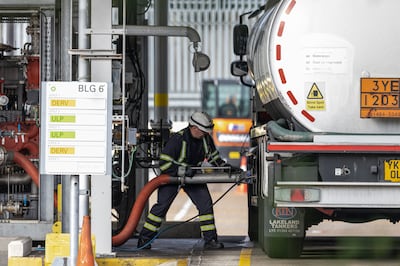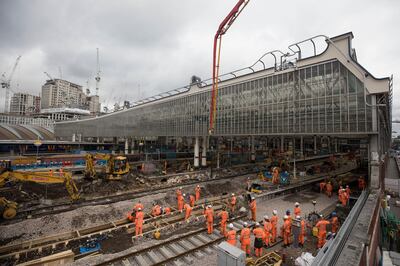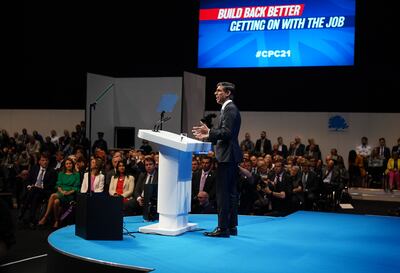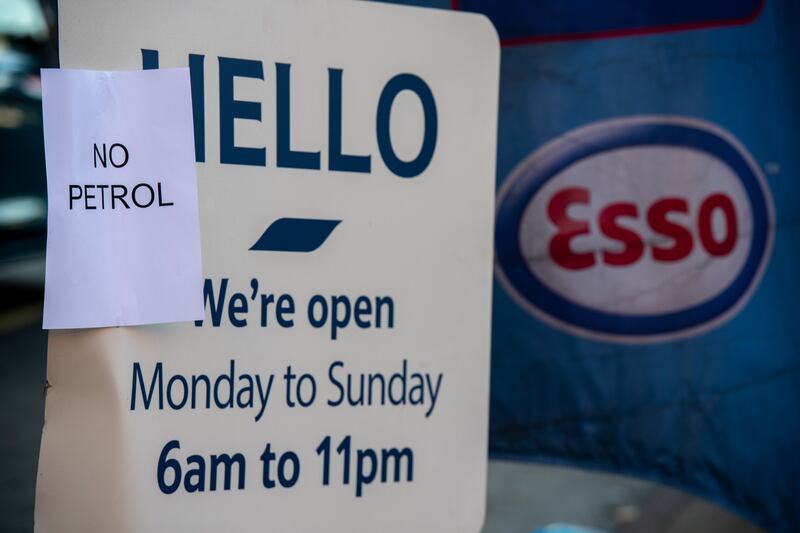With spiralling energy costs, hints of stagflation and supply and staff shortages grinding Britain to a halt, it is all too easy to paint post-Brexit Britain as heading to the doldrums.
While queues of cars snake out from petrol stations with angry motorists fighting over fuel, supermarket shelves are sitting empty and households are facing such high energy bills that many may be forced to keep the heating turned off this winter.
Chancellor of the Exchequer Rishi Sunak said on Monday said he cannot “wave a magic wand” to make supply chain problems go away as industry chiefs warned of empty shop shelves in the run up to the peak Christmas period.
Britain’s exit from the European Union appears to be ending in disarray, a far cry from a new era as a pioneering free trader elevating the fortunes of its citizens and companies alike. So, is the outlook really as bleak as it might seem?
“Overall, there’s little doubt that the fuel crisis and the broadening shortages will slow the UK economy’s recovery,” said Ruth Gregory, senior UK economist at Capital Economics.
UK gross domestic product is set to stagnate in September and October, she said, and grow just 0.4 per cent in the fourth quarter compared with the previous three months, against a previous estimate of 1.6 per cent growth.
“We wouldn’t rule out a monthly fall in GDP. And we don’t expect GDP to get back to its pre-virus level until Q1 2022, which would be a quarter after the eurozone economy,” said Ms Gregory.
UK's supply vulnerabilities exposed
While the UK was able to boast of its world-beating vaccination programme in the first half of the year, a move that allowed the government to unshackle its economy from Covid-19 restrictions in July, since then the country’s vulnerabilities around maintaining its supply chains have become very exposed.
Some of the shortages Britain faces are caused by global challenges, such as the lack of semiconductors, which has constrained car output with a 27 per cent contraction in August when just more than 37,000 cars were manufactured, down from 51,000 a year earlier. This led to a drop of 35 per cent in new registrations in September compared to August - the lowest level in more than two decades with just 214,000 cars sold.
However, the root of the UK's struggles are broader and come down to its dependence on trade.
The country's reliance on natural gas imports for heating and electricity generation, for example, has seen domestic gas prices more than quadruple this year with storage in the UK itself already scarce.
While the situation could ease if a contentious new pipeline, Nord Stream 2, is opened to connect Russia to Germany via the Baltic Se, this depends on political consensus with a lot of wrangling still to come.
“The UK is not always fully aware of how reliant it is on European storage,” said Marco Alvera, head of Italian energy infrastructure company Snam. “If it gets very cold - and it is not a Brexit-related thing - even within Europe you will see countries saying, ‘I have the gas inside my borders, I am going to pass an urgent safety measure that no one can export for the next two weeks.’”

Other shortages are UK-specific and appear to be symptomatic of post-Brexit labour supply issues in the food and HGV transport sectors.
The fuel crisis gripping the nation, caused by a lack of HGV drivers, may provide a temporary boost to fuel sales, Ms Gregory said, but this will also depress non-fuel consumption and weigh on economic activity if people can’t drive to where they need to be.
Even the government says there is little they can do to solve the current issues.
Mr Sunak said the government will do all it can to “mitigate” global supply issues, but he conceded that there is disruption and did not rule out Christmas being affected.
“We're seeing supply disruption, not just here but in lots of different places, and there are things we can try to mitigate, and we are,” he said. “There's nothing I can do about the decision by a country in Asia to shut down a port because of a coronavirus outbreak.”
On Monday, Mr Sunak unveiled £500 million ($677m) in new job support funding, with a focus on getting people into new or better jobs.
Investor concerns amid slowing growth and inflation risks
The gloomy outlook seems far removed from the optimism in the second quarter when Britain’s economy rebounded 5.5 per cent as the country emerged from lockdown.
The unexpected uplift from the initial estimate of 4.8 per cent brought the UK’s performance back in line with the eurozone and a long way from the almost 20 per cent contraction seen in the second quarter of last year.
By July, GDP was only 1 per cent below its February 2020 level, however, the chances of the recovery continuing to outperform the eurozone are fading in the face of the fuel crisis and broadening product and labour shortages, Ms Gregory warned.
The FTSE 100 was flat on Monday morning as the country’s economic challenges played on investor sentiment. While the blue-chip index is up nearly 8.5 per cent so far this year on accommodative central bank policies and reopening optimism, it is 2.3 per cent below the highest point hit this year as inflation risks and signs of slowing local and global economic growth cause investor concern.
“Inflation continues to underpin market sentiment, with fears over a protracted period of above-target prices bringing expectations of a dramatic re-rate in monetary policy expectations,” said Joshua Mahony, senior analyst at IG Group.
“Investors are growing increasingly fearful that the November and December period is characterised by a lack of supply and higher prices.”
While driver shortages have become big news because consumers cannot fill up their cars to get to work, the issue it is also increasingly a problem for businesses, Mr Mahoney warned.
“It could become a significant hindrance on growth as we head towards the critical festive period,” he said.
Loss of pre-Brexit workforce key to current crisis
Last week, retailers such as Boohoo, Next, and Iceland cited logistical issues as a cause of concern.
The loss of a vital pool of labour after Britain's transition out of the EU is one of the immediate crises facing the UK economy. Labour shortages are hitting every part of the food supply chain, from dairy to seafood and vegetable processing, according to James Withers, chief executive of Scottish Food & Drink. Businesses are struggling from a lack of transport for food, as well as a shortage of staff to pack it, he said.
The government now plans to issue short-term visas for lorry drivers and poultry workers, though businesses say it will not come close to filling the gap, as Britain faces record job vacancies of more than one million.
Supermarkets such as Sainsbury’s have already embarked on a winter hiring drive, while Waitrose has increased pay for new hauliers, and along with Amazon is offering bonuses to attract temporary staff before the busy festive period.
“It is clear that employees are the latest commodity that will become increasingly expensive going forward,” said Mr Mahoney.
“From a market perspective, the prospect of higher wages, materials, and logical costs highlights the likeliness that central banks may have to tighten sooner rather than later.”

How the labour market adjusts to the government’s withdrawal of its furlough scheme this month will be central to the timing of any interest rate rise, said Dan Hanson, senior UK economist at Bloomberg Economics, adding that the final stretch of 2021 will see the country face a “challenging mix of slowing growth and rising inflation".
The UK’s inflation rate hit 3.2 per cent in August, its highest level in more than nine years, with the Bank of England expecting inflation to hit 4 per cent towards the end of 2021 and then drop, as the impact of the first lockdown and supply bottlenecks drop out of the figures.
However, economists warn there are few signs this rise is transitory, with Britain’s private sector losing more momentum in September.
The IHS Markit/CIPS Flash Composite Purchasing Managers' Index dropped for a fourth consecutive month to its lowest reading since February, to 54.1 from 54.8 in August, as manufacturing production only rose modestly amid severe supply chain disruption and signs of softening demand, indicating a period of stagflation ahead.
“The September PMI data will add to worries that the UK economy is heading towards a bout of ‘stagflation,’ with growth continuing to trend lower while prices surge ever higher,” warned IHS Markit’s chief business economist Chris Williamson.
The Confederation of British Industry, the biggest business lobby, is urging Boris Johnson to set up an emergency task force to deal with supply shortages and cost of living. The country faces “a perfect inflationary storm” that could plunge the economy into a recession next year, according to Gavekal Research, with retail executives predicting food prices will rise at an annual pace of 5 per cent by the end of the year.
“The recovery is in a very fragile state,” said Karan Bilimoria, the CBI’s president. “The nightmare scenario is a ‘winter of discontent’,” he added, evoking the period in the late 1970s when strikes and shortages led to the downfall of the Labour government. “The basics not being available is what we’ve got to try to prevent.”
Current crisis similar to challenges of postwar Britain
However, Neil Shearing, group chief economist at Capital Economics, said the current fuel shortages, tax increases and stagflation fears are closer to the economic situation following the Second World War than the 1970s.
“Then, as now, there had been a huge shock to the UK’s economic way of life,” he said, with large numbers of workers released from the armed forces into the labour market in the aftermath of the war similar to the 1.6 million workers still on furlough in August now re-entering Britain's workforce.

Ms Gregory said the end of furlough scheme will ease some labour shortages and allow the Bank of England to hold off on raising rates until May 2022, rather than this year, something hinted at by governor Andrew Bailey late last month.
Meanwhile, the CBI Growth Indicator is optimistic for the months ahead, with private sector activity expected to expand at a steady pace in the three months to December, rising by 28 per cent overall with business and professional services firms expecting a 40 per cent boost.
Ultimately, the UK must consider how the country bounced back from its postwar challenges, Mr Shearing said.
“The sky did not fall in”, he said. “In fact, following a recession in 1946, UK GDP growth averaged a solid (though unspectacular) 2.25 per cent a year between 1947 and 1960. This serves as a useful check on some of the more extreme economic pessimism that has prevailed in recent weeks.”







